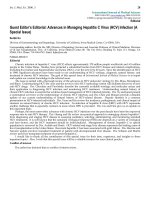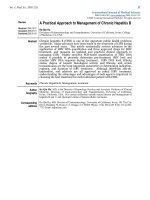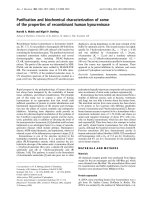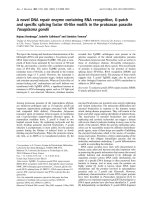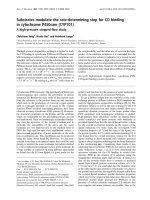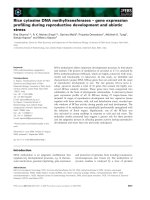Báo cáo y học: " Nuclease-resistant double-stranded DNA controls or standards for hepatitis B virus nucleic acid amplification assays" pptx
Bạn đang xem bản rút gọn của tài liệu. Xem và tải ngay bản đầy đủ của tài liệu tại đây (268.72 KB, 7 trang )
BioMed Central
Page 1 of 7
(page number not for citation purposes)
Virology Journal
Open Access
Research
Nuclease-resistant double-stranded DNA controls or standards for
hepatitis B virus nucleic acid amplification assays
Shuang Meng
1,2
, Sien Zhan
1,2
and Jinming Li*
2
Address:
1
Graduate School, Peking Union Medical College, Chinese Academy of Medical Sciences, PR China and
2
National Center for Clinical
Laboratories, Beijing Hospital, Beijing, PR China
Email: Shuang Meng - ; Sien Zhan - ; Jinming Li* -
* Corresponding author
Abstract
Background: Identical blood samples tested using different kits can give markedly different
hepatitis B virus (HBV) DNA levels, which can cause difficulty in the interpretation of viral load. A
universal double-stranded DNA control or standard that can be used in all commercial HBV DNA
nucleic acid amplification assay kits is urgently needed. By aligning all HBV genotypes (A-H), we
found that the surface antigen gene and precore-core gene regions of HBV are the most conserved
regions among the different HBV genotypes. We constructed a chimeric fragment by overlapping
extension polymerase chain reaction and obtained a 1,349-bp HBV
C+S
fragment. We then packaged
the fragment into lambda phages using a traditional lambda phage cloning procedure.
Results: The obtained armored DNA was resistant to DNase I digestion and was stable,
noninfectious to humans, and could be easily extracted using commercial kits. More importantly,
the armored DNA may be used with all HBV DNA nucleic acid amplification assay kits.
Conclusions: The lambda phage packaging system can be used as an excellent expression platform
for armored DNA. The obtained armored DNA possessed all characteristics of an excellent
positive control or standard. In addition, this armored DNA is likely to be appropriate for all
commercial HBV DNA nucleic acid amplification detection kits. Thus, the constructed armored
DNA can probably be used as a universal positive control or standard in HBV DNA assays.
Background
Hepatitis B virus (HBV) infection is a major public health
problem. It is responsible for chronic liver disease and is
a risk factor for liver cirrhosis and hepatocellular carci-
noma [1-3]. Early diagnosis and measurement of viral
load in patients with HBV is very helpful for the manage-
ment of this disease [2].
Real-time polymerase chain reaction (PCR) assays are
widely used for the detection and quantification of HBV
DNA in clinical samples [4-6]. Quantitative detection of
HBV DNA in serum or plasma provides evidence about
the level of viral replication, degree of infection, and effi-
cacy of antiviral therapy [7-11]. Many commercial kits are
available for HBV DNA quantification. Each kit uses pro-
prietary HBV DNA standards or controls and provides
results unique to that particular method. All of the HBV
DNA nucleic acid amplification detection kits target the
highly conserved surface antigen gene or the precore-core
genes of the HBV genome [10,12-17] and the HBV DNA
controls or standards come from many sources [18-20].
Published: 22 December 2009
Virology Journal 2009, 6:226 doi:10.1186/1743-422X-6-226
Received: 27 October 2009
Accepted: 22 December 2009
This article is available from: />© 2009 Meng et al; licensee BioMed Central Ltd.
This is an Open Access article distributed under the terms of the Creative Commons Attribution License ( />),
which permits unrestricted use, distribution, and reproduction in any medium, provided the original work is properly cited.
Virology Journal 2009, 6:226 />Page 2 of 7
(page number not for citation purposes)
Owing to the lack of a universal HBV DNA standard, iden-
tical blood samples yield markedly different HBV DNA
levels when tested by different kits [21-23]. These incon-
sistent results complicate the interpretation of viral load
and could influence clinicians+ decisions. Thus, there is
an urgent need for a universal and uniform HBV DNA
control or standard.
An ideal control or standard should have the following
characteristics. First, the standard must be easy to prepare.
Second, it must be stabile in storage and during transport.
Third, the standard must be noninfectious to humans and
not pose a safety issue during manufacture and use.
Fourth, the standard should control all steps of the PCR
assay, including extraction and amplification. In DNA
virus-based tests, the commonly used controls or stand-
ards are from 1 of 3 potential sources: plasmid DNA, pos-
itive patient specimens, or commercially available viral
preparations [11,23,24]. None of these is ideal. Plasmid-
derived standards consist of bare, unprotected double-
stranded DNA and may become degraded in the clinical
specimen before nucleic acid extraction or during storage
in the working stock, which could lead to unreliable
amplification results. Moreover, plasmid-derived stand-
ards could not provide control for the entire PCR assay,
because the lysis of viruses during the nucleic acid extrac-
tion procedure is not monitored [4,25]. Patient specimens
are infectious to humans and, thus, there is some diffi-
culty during manufacture and shipment. Further, viral
nucleic acids in patient specimens are degraded during
multiple freeze-thaw cycles. Lastly, commercially availa-
ble viral preparations are heterogeneous or inconsistent
from lot to lot. There is a clear need for an improved pos-
itive control or standard for DNA quantification that over-
comes these limitations [20,26].
There are 3 types of phages that can be used to construct
DNA controls or standards: T7 bacteriophage, lambda
phage, and filamentous phage [25,27-29]. In the quanti-
tative detection of HBV DNA, the efficiency of nucleic acid
purification and amplification of the standards should be
identical to the samples. During the early cycles of real-
time PCR, primer and probe hybridisation site accessibil-
ity is a key aspect in amplification and detection effi-
ciency. The accessibility is primarily determined by the
secondary structure of the target nucleic acids [25]. Obvi-
ously, single-stranded DNA controls that are derived from
filamentous phage cannot mimic HBV double-stranded
DNA properties such as charge and secondary structure.
Thus, filamentous phage is not an optimal choice for gen-
erating DNA controls or standards for the HBV assay.
Compared with T7 bacteriophage, lambda phages possess
greater packaging efficiency and are easier to obtain [29].
Therefore, we constructed the DNA controls or standards
for HBV using lambda phage packaging in vitro.
Lambda phage is a double-stranded DNA phage that can
package exogenous DNA into phage particles in vitro. The
constructed phage DNA particles are called 'armored
DNA'. Armored DNA is produced using mixed bacterial
extracts packaging the exogenous DNA in vitro comple-
mentation and results in the mature phage particles
[28,30]. Armored DNA is DNase-resistant, stable, nonin-
fectious to humans, inexpensive, and easily extracted by
conventional methods. Thus, it is an excellent candidate
for a positive control in the quantification of a DNA virus.
The first report of lambda phage DNA packaging in vitro
was described by Sternberg [31]; it was then optimised by
Frackman in 1996 [32]. In the lambda phage, DNA
sequences can be packaged and propagated. So far, the
largest DNA packaged (425 bp) was prepared using a tra-
ditional lambda phage cloning procedure and was used as
an internal amplification control by Stocher and Berg
[4,20].
In this study, we constructed a double-stranded DNA con-
trol or standard that contained a 1,349-bp HBV fragment
encompassing the highly conserved surface antigen gene
and precore-core genes of the HBV genome using the tra-
ditional lambda phage cloning procedure. We show that
the obtained double-stranded DNA standard is resistant
to DNase I digestion and exhibits improved storage and
handling properties. It can likely be used as a universal
positive control in quantitative HBV DNA amplification
assays.
Results
Verification of the Recombinant Plasmid pGEM- HBV
C+S
The PCR products from the recombinant pGEM- HBV
C+S
(using primers 1 and 4) were full length (1,349 bp; Fig. 1).
Sequencing also demonstrated that the inserted HBV
sequence was 1,349 bp without point mutation. Thus, the
recombinant plasmid pGEM- HBV
C+S
was successfully
constructed.
Identification of Armored DNA by Polymerase Chain
Reaction and Sequencing
The DNA extracted from lambda phages was amplified
with the phage-specific primers gt11-for and gt11-rev. The
resulting PCR products were analysed by electrophoresis
on agarose gel (1%) containing ethidium bromide (Fig. 2)
and sequencing. The result indicated that the sequencing
of the PCR products was accurate and the recombinant
plasmid gt11-HBV
C+S
were successfully packaged by the
phage packaging extracts.
Durability of Armored DNA
The armored DNA was not degraded by DNase I, whereas
the plasmid DNA was completely degraded. This sug-
gested that the generated armored DNA contained intact
Virology Journal 2009, 6:226 />Page 3 of 7
(page number not for citation purposes)
phage particles that could protect the armored DNA from
nuclease degradation (Fig. 3).
Stability of Armored DNA
The armored DNA (10
6
copies/ml or 10
4
copies/ml) in SM
buffer at 4°C was stable at least for 3 months; at 37°C or
room temperature, it was stable for 2 months. However,
the stability of the armored DNA in plasma was poor. The
armored DNA (10
6
copies/ml) in plasma was not stable
for more than 5 days at 4°C, 37°C, or room temperature.
At 10
4
copies/ml, the armored DNA in plasma was not sta-
ble for more than 3 days at 4°C, 37°C or room tempera-
ture (Fig. 4).
Linear Analysis of the Lambda DNA Phage Using a
Hepatitis B Virus DNA Fluorescence Quantitative
Diagnostic Kit
To evaluate the performance of armored DNA as a calibra-
tor for HBV DNA assays, we used the National Reference
HBV DNA, which was assigned using the HBV interna-
tional standard (NIBSC 97/746) to calibrate the serially
diluted armored DNA. The concentrations of the armored
DNA for the 5 dilutions (10
6
, 10
5
, 10
4
, 10
3
, and 10
2
) were
5.85 × 10
6
, 6.81 × 10
5
, 5.23 × 10
4
, 5.45 × 10
3
, and 5.57 ×
10
2
copies/ml, respectively. A 10-fold dilution of armored
DNA produced a linear correlation (r
2
= 0.99; Fig. 5). The
results demonstrated that armored DNA is capable of per-
forming in HBV DNA fluorescence quantitative assays as
a calibration standard for the quantification of HBV DNA.
Discussion
We constructed an armored DNA particle that can func-
tion as a positive control or standard for HBV DNA quan-
tification. During construction, we used the lambda phage
gt11 vectors and EcoRI restriction enzyme cutting sites in
the traditional lambda phage cloning procedure. Because
of protection offered by the phage proteins, the obtained
armored DNA was resistant to DNase I digestion and
exhibited improved storage and handling properties. The
armored DNA has reliable amplification in real-time PCR
assays. Armored DNA is noninfectious to humans and can
be easily extracted by commercial kits; it controls both
extraction and amplification of viral DNA from the sam-
ple. The constructed armored DNA meets all the require-
ments of an ideal standard; thus, it may be an excellent
positive control or standard for the quantification of DNA
viruses.
There is an urgent need for a universal and uniform HBV
DNA control or standard for HBV DNA quantification.
We aligned all HBV genotypes (A-H) and found that the
surface antigen gene and the precore-core gene regions of
HBV show the most sequence similarity among the differ-
ent HBV genotypes [20]. The commercially available HBV
nucleic acid detection kits all target the surface antigen
gene and the precore-core gene regions of HBV [12-
17,33,34]. Therefore, we hypothesised that a chimeric
DNA fragment containing all of the conserved sequences
of the surface gene and precore-core genes of HBV proba-
bly compatible with all HBV nucleic acid amplification
detection kits. We made such a chimeric fragment by over-
lapping extension PCR technology, and then packaged the
1,349-bp fragment into lambda phage. The resulting
armored DNA particles were DNase-resistant, stable, non-
infectious to humans, easily extracted by conventional
Verification of the Recombinant pGEM-HBV
C+S
PlasmidFigure 1
Verification of the Recombinant pGEM-HBV
C+S
Plas-
mid. The PCR amplification products from recombinant
pGEM-HBV
c+s
were analysed using ethidium-bromide-stained
1% agarose gel. Lanes 1, 2, and 3: negative control with no
template; Lane 4: positive control of recombinant clones;
Lane 5 and 6: PCR products of positive recombinant clones.
Identification of Armored DNA by PCR AmplificationFigure 2
Identification of Armored DNA by PCR Amplifica-
tion. The PCR amplification products of the DNA extracted
from lambda phages were analysed using ethidium-bromide
stained 1% agarose gel. Lane 1: negative control with no tem-
plate; Lane 2, 3, 4, 5, and 6: PCR products from positive chi-
meric phages.
Virology Journal 2009, 6:226 />Page 4 of 7
(page number not for citation purposes)
methods, and are likely to be compatible with all HBV
DNA nucleic acid amplification kits. Thus, the constructed
armored DNA control may be used as a universal positive
control or standard for HBV DNA quantification.
Although armored DNA has many advantages as a posi-
tive control, there is still a problem with its stability. Our
experimental data indicated that the armored DNA was
not stable for more than 5 days in plasma at room temper-
ature or at 37°C. It is not clear why the lambda phage con-
trols are less stable than the MS2 bacteriophage controls
[35], but it may be that lambda is susceptible to plasma
proteases. The instability of the armored DNA in plasma
does not conflict with its use as a positive control or stand-
ard. Owing to its stability in SM buffer, armored DNA
diluted in SM buffer may be used as an external positive
control or standard for quantifying the samples accu-
rately. At the same time, both nucleic acid extraction and
amplification can be well controlled.
Conclusions
In conclusion, our results demonstrate that the lambda
phage packaging system can be used as an excellent
expression platform for armored DNA. The obtained
armored DNA is DNase resistant and is amplified linearly.
It also has improved storage and handling properties and,
more importantly, it may be appropriate for all commer-
cial HBV DNA nucleic acid amplification detection kits.
Thus, the constructed armored DNA can likely be used as
a universal positive control or standard in HBV DNA PCR
assays.
Methods
Construction of pGEM-HBV
C+S
An exogenous chimeric sequence (1,349 bp) was con-
structed from the following sequences: HBV-C (nt1819-
2453, 635 bp from the HBV precore-core genes, one of the
most conserved regions of HBV), HBV-S (nt125-838, 714
bp from the HBV surface antigen gene, one of the most
conserved regions of HBV). The target sequence included
the forward primer sites, reverse primer sites, and flanking
regions, which are shown in Table 1. We spliced the 2 tar-
get DNA sequences together using overlapping extension
PCR [36,37]. During the first round of PCR, 2 parts (called
fragments C and S) were amplified from template plasmid
p57-1 (constructed by our laboratory, GenBank accession
Durability of Armored DNAFigure 3
Durability of Armored DNA. Equal amounts of armored DNA and plasmid DNA (extracted from the armored DNA)
were incubated with DNase I (0.1 units/μl) at 37°C for 60 min. After digestion, the samples were analysed by real-time PCR.
The armored DNA was completely resistant to DNase I digestion, whereas plasmid DNA was degraded completely. Armored
DNA and plasmid DNA indicate samples without DNase I digestion.
Virology Journal 2009, 6:226 />Page 5 of 7
(page number not for citation purposes)
no. AY518556) by use of primers 1 and 2 and primers 3
and 4, respectively. Both reactions were performed under
the following conditions: denaturing at 94°C for 5 min,
followed by a 35-cycle program consisting of 94°C for 30
s, 58°C for 30 s, and 72°C for 1 min, and then 10 min of
elongation at 72°C. The PCR products from the first-
round amplifications were gel purified and used as tem-
plates for the next round of PCR. In the second round of
PCR, fragment HBV
C+S
was amplified with primers 1 and
4. The reactions were performed under the following con-
ditions: denaturing at 94°C for 5 min, followed by a 35-
cycle program consisting of 94°C for 30 s, 58°C for 30 s,
and 72°C for 2 min, and then 10 min of elongation at
72°C. The overlapping extension PCR products were puri-
fied and ligated into the pGEM-T Easy vector (Promega
Corporation, USA) to generate the recombinant plasmid
pGEM-HBV
C+S
. The transformed bacteria were selected by
use of blue-white colour identification. The positive con-
structions were confirmed by PCR and sequencing.
Packing and Purification of Armored DNA
The HBV
C+S
fragments were excised from plasmids pGEM-
HBV
C+S
by use of EcoRI restriction enzymes. The HBV
C+S
fragments were purified and inserted into the EcoRI clon-
ing site of lambda phage DNA with the use of the lambda
gt11/EcoRI/CIAP-Treated Vector Kit (Stratagene). A 3-μl
portion of this ligation mixture was then used for phage
packaging in vitro according to the manufacturer's instruc-
tion. The resulting phage particles were transfected into
Escherichia coli host strain Y1088. After incubation at
37°C for 8 h, single positive plaques were selected by
blue-white color identification. Then, the positive phage
particles were amplified in E. coli strain Y1088 in a sepa-
rate 10-cm Petri dish according to the manufacturer's
instruction. The obtained armored DNA particles were
purified by use of the allyl dextran gel chromatography
Stability of the Armored DNAFigure 4
Stability of the Armored DNA. (a) Stability of armored DNA in SM buffer. Armored DNA in SM buffer was stable at 4°C
for more than 3 months, at 37°C or room temperature was stable for 2 months. The mean for low-copy samples at 4°C was
52,722 copies/ml (4.72 log10; range: 49,239-96,210 copies/ml), and the coefficient of variation was 10.1%. The mean for high-
copy samples at 4°C was 5,623,413 copies/ml (6.75 log10; range: 5,510,008-9,575,051 copies/ml), and the coefficient of varia-
tion was 6.3%. (b) The stability of armored DNA in plasma. The stability of armored DNA in plasma was poor. The high-copy
Armored DNA was not stable for more than 5 days at 4°C, 37°C, or room temperature; the low-copy armored DNA in
plasma was not stable for more than 3 days at 4°C, 37°C, or room temperature.
Linear Analysis of the Lambda DNA Phage Using a HBV DNA fluorescence Quantitative diagnostic kitFigure 5
Linear Analysis of the Lambda DNA Phage Using a
HBV DNA fluorescence Quantitative diagnostic kit.
Linearity of the armored DNA was analysed by use of Kehua
HBV DNA fluorescence quantitative assay kit. Armored
DNA was diluted by 10-fold serial dilutions, and then the
samples were quantified using the kit. The samples were
tested in triplicate and the mean values were calculated (r
2
=
0.99).
Virology Journal 2009, 6:226 />Page 6 of 7
(page number not for citation purposes)
purification system, which was used according to the
machine's directions. Finally, the purified armored DNA
were stored in SM buffer (100 mmol/L NaCl, 50 mmol/L
Tris, 8 mmol/L MgSO
4
, 0.1 g/L gelatin, pH 7.5) at 4°C.
Identification of Armored DNA Particles by Polymerase
Chain Reaction and Sequencing
DNA was extracted from 100 μl of purified armored DNA
by using an HBV DNA real-time PCR detection kit (Shang-
hai KeHua Bio-engineering Co., Ltd.) according to the
manufacturer's instruction. The extracted DNA was used
as a template for PCR amplification. Primers gt11-for and
gt11-rev are sequence-specific primers at both ends of the
lambda gt11 vector. PCR was performed in a 50-μl reac-
tion volume, which contained 5 μl of the DNA template,
1× PCR Buffer (TaKaRa, Japan), 1.5 mM MgCl
2
, 300 μM
deoxynucleoside triphosphate, 1.5 μM of each primer
(gt11-for and gt11-rev), and 1.25 U of PrimerStart Taq
DNA polymerase (TaKaRa, Japan). After an initial incuba-
tion at 94°C for 5 min, 35 cycles were performed as fol-
lows: 94°C for 30 s, 58°C for 30 s, and 72°C for 2 min,
followed by a final extension at 72°C for 10 min. The
reaction included a negative control with no template,
which was tested simultaneously. The PCR products (5 μl)
were analysed by electrophoresis on agarose gel (1%) con-
taining ethidium bromide. The PCR products were puri-
fied and ligated with the pGEM-T Easy vectors (Promega
Corporation, USA) for sequencing.
Nuclease Resistance of the Lambda DNA Phage
To examine whether the obtained armored DNA was
nuclease resistant, we incubated armored DNA with
DNase I (0.1 units/μl) at 37°C for 60 min, at the same
time, equal amount of plasmid DNA (extracted from the
armored DNA) was incubated with DNase I (0.1 units/μl)
as the control group. After digestion, the samples were
analysed by real-time PCR using a HBV DNA real-time
PCR detection kit (Shanghai KeHua Bio-engineering Co.,
Ltd.).
Stability of the Armored DNA
The armored DNA was examined for its stability in SM
buffer and plasma. Initially, the purified armored DNA
was quantified in duplicate using a HBV DNA fluores-
cence quantitative diagnostic kit (Shanghai Kehua Bio-
Engineering Co., Ltd.). The quantified armored DNA was
diluted to obtain 10,000 and 1,000,000 copies/ml. For
each stability study, a single batch was separated into aliq-
uots of 100 μl for each time point. The samples were then
incubated at 4°C, 37°C, or room temperature. The
armored DNA samples were quantified at each time by
use of a HBV DNA fluorescence quantitative diagnostic kit
(Shanghai Kehua). The data were analysed by use of the
LightCycler software (Roche).
Linear Analysis of the Lambda DNA Phage Using a
Hepatitis B Virus DNA Fluorescence quantitative
diagnostic kit
The purified armored DNA was quantified by use of a
HBV DNA fluorescence quantitative diagnostic kit
(Shanghai Kehua). We used the National Reference mate-
rials as the calibration standards for HBV DNA detection.
The National Reference materials were assigned using the
WHO international standard for HBV DNA (NIBSC 97/
746) assay. The quantified armored DNA was diluted by
10-fold serial dilution to obtain samples containing 10
6
to
10
2
copies/ml. The samples were then tested in triplicate
and the quantification values averaged.
Competing interests
The authors declare that they have no competing interests.
Authors' contributions
SM and SZ planned the experimental design and carried
out construction of the armored DNA. SM drafted the
manuscript. JL conceived the study, participated in its
design and coordination, and helped to revise the manu-
script. All authors read and approved the final manu-
script.
Acknowledgements
This study was supported in part by the National Natural Science Founda-
tion of China (30371365).
References
1. Lai CL, Ratziu V, Yuen MF, Poynard T: Viral hepatitis B. Lancet
2003, 2:2089-2094.
Table 1: Primers used in the experiment
Primer name Primer sequence (5' to 3')
Primer 1 5'-CCGGAATTCACTTTTTCACCTCTGCCTAATCATC-3'
Primer 2 5'-GGTACAGGGTCCCCAATCTTCGATAACTAACATTGGGATTCCCGAGAT
TG-3'
Primer 3 5'-ATCTCGGGAATCTCAATGTTAGTTATCGAAGATTGGGGACCCTGTACC-
3'
Primer 4 5'-CCGGAATTCGGTTTAAATGTATACCCAAAGACAAAAG-3'
gt11-for 5'-CGACTCCTGGAGCCCG-3'
gt11-rev 5'-TGACACCAGACCAACTGGTAATG-3'
Note: The bold sequences are Eco RI restriction enzyme sites; the underlined sequences are overlapping nucleotide sequences.
Publish with BioMed Central and every
scientist can read your work free of charge
"BioMed Central will be the most significant development for
disseminating the results of biomedical research in our lifetime."
Sir Paul Nurse, Cancer Research UK
Your research papers will be:
available free of charge to the entire biomedical community
peer reviewed and published immediately upon acceptance
cited in PubMed and archived on PubMed Central
yours — you keep the copyright
Submit your manuscript here:
/>BioMedcentral
Virology Journal 2009, 6:226 />Page 7 of 7
(page number not for citation purposes)
2. Changotra H, Sehajpal PK: Quantitative detection of serum
HBV DNA levels employing a new S gene based cPCR assay.
Arch Virol 2005, 50:481-491.
3. Laperche S, Thibault V, Bouchardeau F, Alain S, Castelain S, Gassin M,
Gueudin M, Halfon P, Larrat S, Lunel F, Martinot-Peignoux M, Mercier
B, Pawlotsky JM, Pozzetto B, Roque-Afonso AM, Roudot-Thoraval F,
Sauné K, Lefrère JJ: Expertise of laboratories in viral load quan-
tification, genotyping, and precore mutant determination
for hepatitis B virus in a multicenter study. J Clin Microbiol 2006,
44:3600-3607.
4. Stöcher M, Berg J: Internal control DNA for PCR assays intro-
duced into lambda phage particles exhibits nuclease resist-
ance. Clin Chem 2004, 50:2163-2166.
5. Yeon JE: Technique for the early detection of drug-resistant
HBV DNA during antiviral therapy. Intervirology 2008, 1:7-10.
6. Mackay IM, Arden KE, Nitsche A: Real-time PCR in virology.
Nucleic Acids Res 2002, 30:1292-1305.
7. Biswas R, Tabor E, Hsia CC, Wright DJ, Laycock ME, Fiebig EW, Ped-
dada L, Smith R, Schreiber GB, Epstein JS, Nemo GJ, Busch MP: Com-
parative sensitivity of HBV NATs and HBsAg assays for
detection of acute HBV infection. Transfusion 2003, 43:788-798.
8. Mommeja-Marin H, Mondou E, Blum MR, Rousseau F: Serum HBV
DNA as a marker of efficacy during therapy for chronic HBV
infection: analysis and review of the literature. Hepatology
2003, 37:1309-1319.
9. Berger A, Preiser W, Doerr HW: The role of viral load determi-
nation for the management of human immunodeficiency
virus, hepatitis B virus and hepatitis C virus infection. J Clin
Virol 2001, 20:23-30.
10. Paraskevis D, Haida C, Tassopoulos N, Raptopoulou M, Tsantoulas D,
Papachristou H, Sypsa V, Hatzakis A: Development and assess-
ment of a novel real-time PCR assay for quantitation of HBV
DNA. J Virol Methods 2002, 103:201-212.
11. Lole KS, Arankalle VA: Quantitation of hepatitis B virus DNA
by real-time PCR using internal amplification control and
dual TaqMan MGB probes. J Virol Methods 2006, 135:83-90.
12. Allice T, Cerutti F, Pittaluga F, Varetto S, Gabella S, Marzano A,
Franchello A, Colucci G, Ghisetti V: COBAS AmpliPrep-COBAS
TaqMan hepatitis B virus (HBV) test: a novel automated
real-time PCR assay for quantification of HBV DNA in
plasma. J Clin Microbiol 2007, 45:828-834.
13. Yuan HJ, Yuen MF, Wong DK, Sum SS, Lai CL: Clinical evaluation
of the digene hybrid capture II test and the COBAS AMPLI-
COR monitor test for determination of hepatitis B virus
DNA levels. J Clin Microbiol 2004, 42:3513-3517.
14. Ciotti M, Marcuccilli F, Guenci T, Prignano MG, Perno CF: Evalua-
tion of the Abbott RealTime HBV DNA assay and compari-
son to the Cobas AmpliPrep/Cobas TaqMan 48 assay in
monitoring patients with chronic cases of hepatitis B. J Clin
Microbiol 2008, 46:1517-1519.
15. Lindh M, Hannoun C: Dynamic range and reproducibility of
hepatitis B virus (HBV) DNA detection and quantification by
Cobas Taqman HBV, a real-time semiautomated assay. J Clin
Microbiol 2005, 43:4251-4254.
16. Deiman B, Jay C, Zintilini C, Vermeer S, van Strijp D, Venema F, van
de Wiel P: Efficient amplification with NASBA of hepatitis B
virus, herpes simplex virus and methicillin resistant Staphy-
lococcus aureus DNA. J Virol Methods 2008, 151:283-293.
17. Kohmoto M, Enomoto M, Yano Y, Otani S, Minamitani S, Tamori A,
Habu D, Takeda T, Shiomi S, Seki S, Arakawa T, Nishiguchi S: Detec-
tion of serum hepatitis B virus DNA by real-time quantita-
tive polymerase chain reaction (TaqMan PCR) during
lamivudine treatment: comparison with three other assays.
Hepatol Res 2003, 26:125-133.
18. Qian WP, Tan YQ, Chen Y, Peng Y, Li Z, Lu GX, Lin MC, Kung HF,
He ML, Shing LK: Rapid quantification of semen hepatitis B
virus DNA by real-time polymerase chain reaction. World J
Gastroenterol 2005, 11:5385-5389.
19. Daniel HD, Fletcher JG, Chandy GM, Abraham P: Quantitation of
hepatitis B virus DNA in plasma using a sensitive cost-effec-
tive "in-house" real-time PCR assay. Indian J Med Microbiol 2009,
27:111-115.
20. Walkerpeach CR, Pasloske BL: DNA bacteriophage as controls
for clinical viral testing. Clin Chem 2004, 50:1970-1971.
21. Zaaijer HL, ter Borg F, Cuypers HT, Hermus MC, Lelie PN: Com-
parison of methods for detection of hepatitis B virus DNA. J
Clin Microbiol 1994, 32:2088-2091.
22. Saldanha J, Gerlich W, Lelie N, Dawson P, Heermann K, Heath A,
WHO Collaborative Study Group: An international collabora-
tive study to establish a World Health Organization interna-
tional standard for hepatitis B virus DNA nucleic acid
amplification techniques. Vox Sang 2001, 80:63-71.
23. Shyamala V, Arcangel P, Cottrell J, Coit D, Medina-Selby A, McCoin
C, Madriaga D, Chien D, Phelps B: Assessment of the target-cap-
ture PCR hepatitis B virus (HBV) DNA quantitative assay
and comparison with commercial HBV DNA quantitative
assays. J Clin Microbiol 2004, 42:5199-5204.
24. Heermann KH, Gerlich WH, Chudy M, Schaefer S, Thomssen R: Quan-
titative detection of hepatitis B virus DNA in two international
reference plasma preparations. J Clin Microbiol 1999, 37:68-73.
25. Gotsch A, Schubert A, Bombis A, Wiedmann M, Zauke M, Schorling S:
Nuclease-resistant single-stranded DNA controls for nucleic
acid amplification assays. J Clin Microbiol 2007, 45:2570-2574.
26. Benchimol S, Lucko H, Becker A: Bacteriophage lambda DNA
packaging in vitro. The involvement of the lambda FI gene
product, single-strand DNA, and a novel lambda-directed pro-
tein in the packaging reaction. J Biol Chem 1982, 257:5201-5210.
27. Shyamala V, Arcangel P, Cottrell J, Coit D, Medina-Selby A, McCoin
C, Madriaga D, Chien D, Phelps B: Assessment of the target-cap-
ture PCR hepatitis B virus (HBV) DNA quantitative assay
and comparison with commercial HBV DNA quantitative
assays. J Clin Microbiol 2004, 42:5199-5204.
28. Hohn B, Wurtz M, Klein B, Lustig A, Hohn T: Phage lambda DNA
packaging, in vitro. J Supramol Struct 1974, 2:302-317.
29. Masker WE, Kuemmerle NB, Allison DP: In vitro packaging of bacte-
riophate T7 DNA synthesized in vitro. J Virol 1978, 27:149-163.
30. Sternberg N, Tiemeier D, Enquist L: In vitro packaging of a
lambda Dam vector containing EcoRI DNA fragments of
Escherichia coli and phage P1. Gene 1977, 1:255-280.
31. Hohn B, Murray K: Packaging recombinant DNA molecules
into bacteriophage particles in vitro. Proc Natl Acad Sci USA
1977, 74:3259-3263.
32. Stöcher M, Leb V, Berg J: A convenient approach to the gener-
ation of multiple internal control DNA for a panel of real-
time PCR assays. J Virol Methods 2003, 108:1-8.
33. Weiss J, Wu H, Farrenkopf B, Schultz T, Song G, Shah S, Siegel J: Real
time TaqMan PCR detection and quantitation of HBV geno-
types A-G with the use of an internal quantitation standard.
J Clin Virol 2004, 30:86-93.
34. Kessler HH: Comparison of currently available assays for
detection of hepatitis B virus DNA in the routine diagnostic
laboratory. Expert Rev Mol Diagn 2005, 5:531-536.
35. Wei Y, Yang C, Wei B, Huang J, Wang L, Meng S, Zhang R, Li J:
RNase-resistant virus-like particles containing long chimeric
RNA sequences produced by two-plasmid coexpression sys-
tem. J Clin Microbiol 2008, 46:1734-1740.
36. Horton RM, Hunt HD, Ho SN, Pullen JK, Pease LR: Engineering
hybrid genes without the use of restriction enzymes: gene
splicing by overlap extension. Gene 1989, 77:61-68.
37. Heckman KL, Pease LR: Gene splicing and mutagenesis by PCR-
driven overlap extension. Nat Protoc 2007, 2:924-932.
